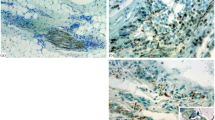Summary
The influence of hydrocortisone acetate on the incorporation of3H-thymidine,3H-proIine and35S-sulfate in experimental intima proliferation was investigated. Intima proliferation was produced by double stenosis of the aorta abdominalis of rats. The following results were obtained:
-
1.
Hydrocortisone acetate caused a considerable inhibition of proliferating intima changes. Moreover, the3H-thymidine-index was decreased.
-
2.
After administration of hydrocortisone acetate an increase of grain-density above cells which had incorporated3H-thymidine was observed. In addition, these cells were investigated caryometrically. Eventual causes of this phenomenon are discussed.
-
3.
At the maximum of proliferation the incorporation of3H-proline and35S-sulfate in proliferating intima cells was decreased after administration of hydrocortisone acetate.
Zusammenfassung
Es wurde der Einflu\ von Hydrocortisonacetat auf den Einbau von3H-Thymidin,3H-Prolin und35S-Sulfat in die experimentelle Intimaproliferation untersucht. Die Intimaproliferation wurde durch doppelte Stenosierung der Aorta abdominalis bei Ratten erzeugt. Die Untersuchungen hatten folgende Ergebnisse:
-
1.
Hydrocortisonacetat bewirkt unter den verwendeten Versuchsbedingungen eine erhebliche Hemmung der proliferativen IntimaverÄnderungen. Der3H-Thymidin-Index ist dabei erniedrigt.
-
2.
Für die nach Hydrocortison-Gaben beobachtete Erhöhung der Silberkorndichte über den mit3H-Thymidin markierten Intimazellkernen werden unter Berücksichtigung der Ergebnisse karyometrischer Untersuchungen in Frage kommende Ursachen diskutiert.
-
3.
Zum Zeitpunkt des Proliferationsmaximums ist der Einbau von3H-Prolin und35S Sulfat in die proliferierte Intima nach Hydrocortisonacetat-Applikation herabgesetzt.
Similar content being viewed by others
Literatur
Birkhead, N. C., H. P. Wagener, andR. M. Shick: Treatment of temporal arteritis with adrenal corticosteroids. J. Amer. med. Ass.163, 821–827 (1957).
Boström, H., K. Berntsen, andM. W. Whitehouse: Biochemical properties of antiinflammatory drugs. II. Some effects on sulfat-35 S metabolism in vivo. Biochem. Pharmacol.13, 413–420 (1964).
Delbrück, A.: Zur Enzymologie der Bindegewebe. Enzymol. biol. clin.4, 84–106 (1964).
Friedman, M., S. Byers, andS. St. George: Cortisone and experimental atherosclerosis. Arch. Path.77, 142–158 (1964).
Goder, G., H. David u.I. Uerlings: Elektronenmikroskopische Befunde an der GefÄ\wand bei Arteriitis temporalis. Albrecht v. Graefes Arch. Ophthal.169, 12–29 (1966).
Gumbinas, M., R. J. Krone, andD. J. Ferguson: Treatment of experimental pulmonary arteriosclerosis with cortisone, heparin and fibrinolysin. J. Atheroscler. Res.6, 381–385 (1966).
Junge-Hülsing, G.: Untersuchungen zur Pathophysiologie des Bindegewebes. Heidelberg: Dr. Alfred Hüthig 1965.
Kaiser, H.: Cortisonderivate in Klinik und Praxis. Darmstadt: E. Merck A. G. 1957.
Kunz, J., D.Kranz u. O.Keim: Autoradiographische Untersuchungen der Synthese von DNS, Kollagen und Mukopolysacchariden bei der experimentellen Proliferation der Aortenintima. Virchows Arch. path. Anat. (1967) (im Druck).
Löwe, H.: Das Kollagen und die Beeinflussung seiner Synthese und Strukturierung durch Cortisonderivate. Dtsch. Gesundh.-Wes.21, 1279–1284 (1966).
Maurer, W., u.E. Primbsch: Grö\e der \-Selbstabsorption bei der H3-Autoradiographie zur Massenbelegung. Exp. Cell Res.33, 8–18 (1964).
Schwarz, W., u.A. Kutzsche: Elektronenmikroskopische Untersuchungen über die anabole und katabole Wirkung von Dexamethason und Methenolester auf Fibroblasten in vitro. Klin. Wschr.44, 979–982 (1966).
Seifert, R., andH. Hilz: Selective and reversible inhibition of proliferation and influence on metabolic functions in L cells by low cortisol concentrations. Acta endocr. (Kbh.)53, 189–204 (1966).
Stöcker, E., u.W. D. Heine: über die Proliferation von Nieren- und Leberepithel unter normalen und pathologischen Bedingungen. Beitr. path. Anat.131, 410–434 (1965).
Wolfart, W.: Histoautoradiographische Untersuchungen zum Stoffwechsel und zur Genese des tuberkulösen Granulationsgewebes. Beitr. path. Anat.129, 436–483 (1963/64).
Author information
Authors and Affiliations
Rights and permissions
About this article
Cite this article
Kunz, J., Kranz, D. & Keim, O. Zur Wirkung von Hydrocortisonacetat auf den Zellstoffwechsel bei der experimentellen Intimaproliferation der Rattenaorta. Virchows Arch. path Anat. 342, 353–360 (1967). https://doi.org/10.1007/BF00960490
Received:
Issue Date:
DOI: https://doi.org/10.1007/BF00960490




